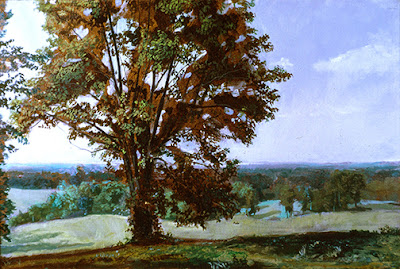Sometimes Art Museums Make Breakthroughs Possible
Philip Koch, North of Bloomington, oil on canvas, 16 x 24 inches
1971
Sometimes art museums can make all the difference.
That happened to me in the summer of 1971. I was ending the first year of my MFA Painting program at Indiana University. By making lots of paintings I was growing as an artist. I also felt drawn to the University's art museum (now called the Eskenazi Museum of Art) and spent considerable time studying its Permanent Collection.
There were two paintings in particular that jolted me into seeing and thinking about painting differently. Both were seemingly quiet landscapes by Hudson River School painters that had only just entered the Museum's collection.
Jasper Cropsey, American Harvesting, oil on canvas, 1851
Eskenazi Museum of Art, Bloomington, IN
My earlier years as a beginning painter consisted of me applying flat abstract shapes of color to a surface. Seeing depth as part of the expression escaped me. I remember distinctly standing before Jasper Cropsey's American Harvesting and feeling pulled into its deep spaces. I literally counted the number of overlapping planes of space marching from the foreground all the way back to its distant sky (I think I counted seven).
After this I went searching for locations around town where I could find similar deep spaces carved out by overlapping planes. The best view for this I found be on the town's golf course and I painted for me a real breakthrough oil, North of Bloomington. (I did have some close calls with flying golf balls).
Philip Koch, Lake Lemon, oil on canvas, 16 x 23 inches, 1971
The other big success I had that year was my oil Lake Lemon. Another painting at the Museum, John Kensett's Water Scene, struck me with the artist's focused use atmospheric perspective to suggest depth and give the air itself a personality. One morning I drove to nearby Lake Lemon early enough to see mists on the lake altering the colors of the distant shoreline. Having seen the Kennett I realized how I could use this to instill a new quality into my painting.
John Frederick Kennett, Water Scene, oil on canvas,
circa 1860's, Eskenazi Museum of Art, Bloomington, IN
Kensett's example also prodded me to think more about asymmetry and contrasting textured and patterned surfaces against smooth and visually restful areas. To this day these lessons echo through my works.
It's not widely appreciated how strongly art museum collections can speak to contemporary artists. Anyone who looks at my paintings side by side with a 19th century work will immediately sense the profound difference in their tenor and feeling. We are all so much a product of our own times. A painter who honestly paints from their experience can't help but produce works that reflect contemporary times.
Anyway, thank you Eskenazi Museum! By the way, the Museum has been closed for a major renovation for several years and is reopening in Fall 2019.






